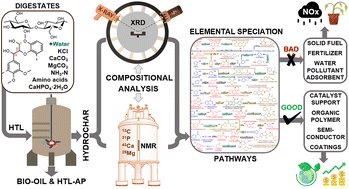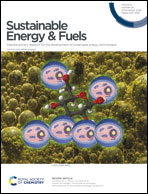Probing elemental speciation in hydrochar produced from hydrothermal liquefaction of anaerobic digestates using quantitative X-ray diffraction†
Abstract
Valorization of hydrochar, a solid byproduct from hydrothermal liquefaction (HTL) of anaerobically-digested agriculture wastes (digestates), requires fundamental knowledge of elemental speciation. This study investigated the effects of reaction temperatures (320–360 °C), digestate pH (3.5–8), and digestate cellulose-to-lignin ratios (0.2–1.8) on the speciation (chemical form) and composition of organics and inorganics in hydrochars produced during hydrothermal treatment. Quantitative X-ray diffraction (XRD) method was the primary technique used to characterize hydrochars. The comprehensive XRD pattern processing including the Rietveld refinement protocols demonstrated that the organic phase was comprised of mostly crystalline monocyclic, heterocyclic, and polycyclic aromatics with diverse aliphatic and aromatic substituents, while the inorganic mineral phase consisted of calcium-phosphates, magnesium-phosphates, calcium-carbonates, and magnesium-carbonates. XRD results were validated by the elemental yields of products and the distribution of chemical functionalities measured using solid-state nuclear magnetic resonance (NMR) spectroscopy. The characterization data were used to evaluate proposed mechanistic pathways using compositional analysis of biocrude and aqueous-phase coproducts. Mechanistic pathways developed in the study suggested that benzoic acids, phenols, benzaldehydes, phenolic aldehydes, α-dicarbonyls, and α-hydroxycarbonyls were responsible for the precipitation of organics through various reactions depending on operating conditions. Meanwhile, the formation of inorganic compounds appeared to be consistently represented by reactions including dehydration, hydrolysis, endergonic reduction, and structure rearrangement of native minerals in the digestates. This study provides basic knowledge needed to create and assess potential elemental speciation pathways. In addition, the results of the study facilitate the specification of process conditions to optimize targeted utilization routes of hydrochar for more economically-feasible and sustainable HTL processing.

- This article is part of the themed collection: Sustainable Energy & Fuels Recent HOT Articles


 Please wait while we load your content...
Please wait while we load your content...
